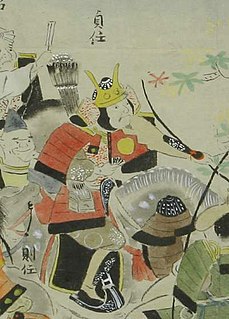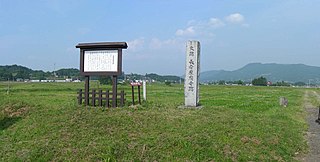Emperor Go-Reizei was the 70th emperor of Japan, according to the traditional order of succession.

The Northern Fujiwara were a Japanese noble family that ruled the Tōhoku region of Japan during the 12th century as their own realm. They succeeded the semi-independent Emishi families of the 11th century who were gradually brought down by the Minamoto clan loyal to the Imperial Court in Kyoto. Ultimately they were conquered by the Kantō samurai clans led by Minamoto no Yoritomo. The Ōshū Fujiwara were one of the four great clans during the Heian period — the other three were the Minamoto, the Taira, and the Tachibana.

Minamoto No Yoshiie, also known as Hachimantarō, was a Minamoto clan samurai of the late Heian period, and Chinjufu-shōgun.

Ōshū is a city located in Iwate Prefecture, Japan. As of 30 April 2020, the city had an estimated population of 114,620 and a population density of 120 persons per km² in 45,728 households. The total area of the city is 993.30 square kilometres (383.52 sq mi). Ōshū is famous for its Maesawa Beef, numerous festivals, historic temples and shrines and Fujiwara no Sato, a theme park and movie lot based on the exploits of the Northern Fujiwaras in the 12th century. Many famous people claim Ōshū as their home, including Ichiro Ozawa, the long-time leader of the Democratic Party of Japan.
The Zenkunen War, also known in English as the Former Nine Years' War or the Early Nine Years' War, was fought from 1051 to 1063, in Japan's Mutsu Province, at the far north of the main island of Honshū. Like the other major conflicts of the Heian period, such as the Gosannen War and the Genpei War, the Zenkunen war was a struggle for power within the samurai clans.
The Abe clan was one of the oldest of the major Japanese clans (uji); and the clan retained its prominence during the Sengoku period and the Edo period. The clan's origin is said to be one of the original clans of the Yamato people; they truly gained prominence during the Heian period (794-1185), and experienced a resurgence in the 18th century. Abe is also a very common Japanese surname in modern times, though not everyone with this name is necessarily descended from this clan.

Minamoto no Yoriyoshi was a head of Japan's Minamoto clan. Along with his son Minamoto no Yoshiie, he led the Imperial forces against rebellious forces in the north. This campaign would be called the Zenkunen War, and would be followed some years later by the Gosannen War. His childhood name was Odaimaru (王代丸).
The siege of Kuriyagawa was a battle during the Heian period of Japan.
The battle of Kawasaki was the first major battle of the Early Nine Years' War (1051-1063). It was fought between the forces of the Abe clan, led by Abe no Sadato, and those of the Minamoto clan, acting as agents of the Imperial Court, and led by Minamoto no Yoriyoshi and his eighteen-year-old son Yoshiie.

Abe no Sadatō was a samurai of the Abe during the Heian period of Japan. Sadato was the son of Abe no Yoritoki, the chinjufu-shōgun. In the Zenkunen War, Sadato fought alongside his father against the Minamoto.
The Kiyohara clan was a powerful clan of the far north of Japan during the Heian period, descended from Prince Toneri, son of Emperor Tenmu (631–686).
Abe no Yoritoki (安倍頼時) was the head of the Abe clan of Emishi who were allowed to rule the six Emishi districts in the Kitakami Basin from Morioka to Hiraizumi in what is now Iwate Prefecture.

Fujiwara no Kiyohira was a samurai of mixed Japanese-Emishi parentage of the late Heian period (794–1185), who was the founder of the Hiraizumi or Northern Fujiwara dynasty that ruled Northern Japan from about 1100 to 1189.
Fujiwara no Tsunekiyo was a member of the martial Hidesato branch of the Fujiwaras and was the father of Fujiwara no Kiyohira, founder of the Northern Fujiwara dynasty in Japan. From the Japanese viewpoint he was considered a notorious traitor.

The Isawa River is a river in Iwate Prefecture, Japan. For about half its length it marks the border between Kanegasaki Town and Ōshū City. The river's origin is in the Ōu Mountains just west of Mt. Yakeishi. At its highest point it is called the Sugiyachi Stream and flows south until it crosses National Route 397. There it turns west and follows 397 until it is stopped by the Ishibuchi Dam.
The Emishi, written with Chinese characters that literally mean "shrimp barbarians," constituted an ancient ethnic group of people who lived in parts of Honshū, especially in the Tōhoku region, referred to as michi no oku in contemporary sources.

Tonomi Palisade was an early Heian period jōsaku-style Japanese castle located in what is now the town of Kanegasaki in Isawa District, Iwate Prefecture in far northern Honshū, Japan. The site was proclaimed a National Historic Site of Japan in October 2013.

Isawa Castle was an early Heian period jōsaku-style Japanese castle located in what is now part of the city of Ōshū, Iwate in the Tōhoku region of far northern Honshu, Japan. The site was proclaimed a National National Historic Site in 1922.

Chōjagahara temple ruins is an archaeological site with the ruins of a late Heian period Buddhist temple located in what is now the city of Ōshū, in northern Japan. The site was protected by the central government as a National Historic Site in the year 2002.










